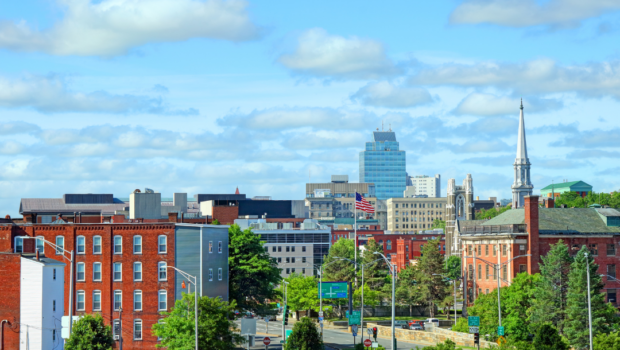Inclusionary Zoning: How Worcester Can Creatively Encourage Affordable Housing Development
David Sullivan, Director of Economic Development & Business Recruitment
WORCESTER – Right now, Worcester is experiencing a period of rapid growth. Lately, it seems like a new major housing development is being announced or completed every few weeks. With momentum at an all-time high, Worcester may soon adopt a policy to ensure that there is a component of affordability provided by each new multifamily development.
This policy, commonly called inclusionary zoning, is something that the Worcester Regional Chamber of Commerce is working hard to ensure is implemented in a way that does not halt the economic development momentum the city has been experiencing.
The housing crisis in America has hit Worcester hard. The city grew by 25,000 residents in the last decade, while only 10,000 units of housing were built. As a result, Worcester has become one of the hottest residential real estate markets in the country as supply becomes shorter than demand. Developers have been making strides to meet this challenge, with a massive number of housing units coming online.
By the Chamber’s analysis, there are more than 3,900 units of housing in major developments in the pipeline in Worcester, with just a little over 500 being affordable housing. While the city is in need of new market-rate housing, it also desperately needs affordable housing that is reserved for lower-income residents, workers, and families.
Rising rents and housing costs have begun to price out many working-class and middle-class families who have lived and worked in Worcester for years. Discussions about affordable housing have long been taking place in the city, without much systemic change. Now, it seems a tangible solution may be presenting itself: inclusionary zoning.
Inclusionary zoning is essentially a requirement of a certain amount of affordable housing that must be included in every new multifamily development in a municipality. It is set by zoning ordinance, and 141 communities in Massachusetts have some form of inclusionary zoning.
While for years Worcester struggled to attract large developers’ attention, the city’s recent momentum finally means it can become more selective and intentional with how it pursues its housing strategy. “We believe it’s the right time for such a policy,” says Peter Dunn, Chief Development Officer for the City of Worcester.
In 2019, the Chamber put out a study titled “Worcester for Everyone”. The study analyzed a potential shortfall in housing units and called for a substantial increase in housing production for all types – including market-rate and affordable. Worcester’s business community is sustained by talent, and workers need a wide array of places to live if Worcester wishes to maintain the diversity of the community.
As such, the Chamber has been active in promoting affordable housing options to developers. The Chamber played a significant role in attracting developers who have added to the city’s affordable housing stock, such as Trinity Financial with the 118 mixed-income units at Courthouse Lofts and Boston Capital with the incoming 83 units of affordable housing at Table Talk Lofts on Kelley Square.
However, the Chamber also understands that for a developer to build affordable, they must have a certain level of expertise and capacity for applying to housing subsidies, managing tenant or buyer applications, and handling other legal matters related to income reserved housing. Given these constraints, as well as the existing economic conditions developers face with skyrocketing costs, the Chamber is supportive of inclusionary zoning only as long as the city provides flexibility and benefits for developers in the new ordinance.
The City of Worcester’s Executive Office of Economic Development recently put forth an initial proposal to the City Council’s Economic Development Committee with a set of components that they recommend. The proposal stated that the ordinance should take effect on any multifamily development creating 12 or more new units, that the developer would have a choice between ensuring 15% of their habitable square footage is reserved for residents earning 80% of the Area Median Income (AMI) or 10% for 60% of AMI, that it would apply to both rentals and condos, that the affordability restriction would last thirty years, and that there would be an option for a payment-in-lieu-of construction.
The proposal also included suggestions for applying certain incentives to developments that build more affordable housing than required, and some common language found in inclusionary zoning ordinances for ensuring the design and quality of the affordable units is not different than the market-rate units. There would also be a provision for ensuring local residents are first in line to purchase these units.
The Chamber spoke at the Economic Development Committee meeting in July when inclusionary zoning was introduced and has been in communication with city councilors about moving the ordinance forward in a way that creatively incentivizes affordable housing without placing an undue burden on developers. During the meeting, committee chair Sean Rose noted that all the councilors “were in support” of inclusionary zoning and that the discussion would need to focus on the components of the ordinance.
The Chamber noted during the meeting that the most important components would be the ones that give developers options – the choice between developing units for 60% of AMI or 80% of AMI, and the option for a payment-in-lieu-of construction. The payment-in-lieu option is one that is common in communities with inclusionary zoning, allowing the developer to elect to pay a nominal fee to the city’s new Affordable Housing Trust Fund rather than construct the units.
Payment-in-lieu will not only be a crucial tool for developers – especially local small developers – who may not have the necessary expertise in affordable housing. It will also provide a steady revenue stream for the trust fund to support other affordable housing developments.
During the Economic Development Committee meeting, Councilor Rose noted that this was just the beginning of the process, and that actual language would need to be drafted, sent back to the committee for approval, and then the ordinance would go to the planning board and city council for final approval. The Chamber noted that the developer community must continue to be a part of this discussion.
It is anticipated that the ordinance could take effect at the start of 2023, with any previously permitted developments at that point not needing to comply. The Chamber will continue to facilitate conversations on an effective and flexible inclusionary zoning ordinance throughout this process.






